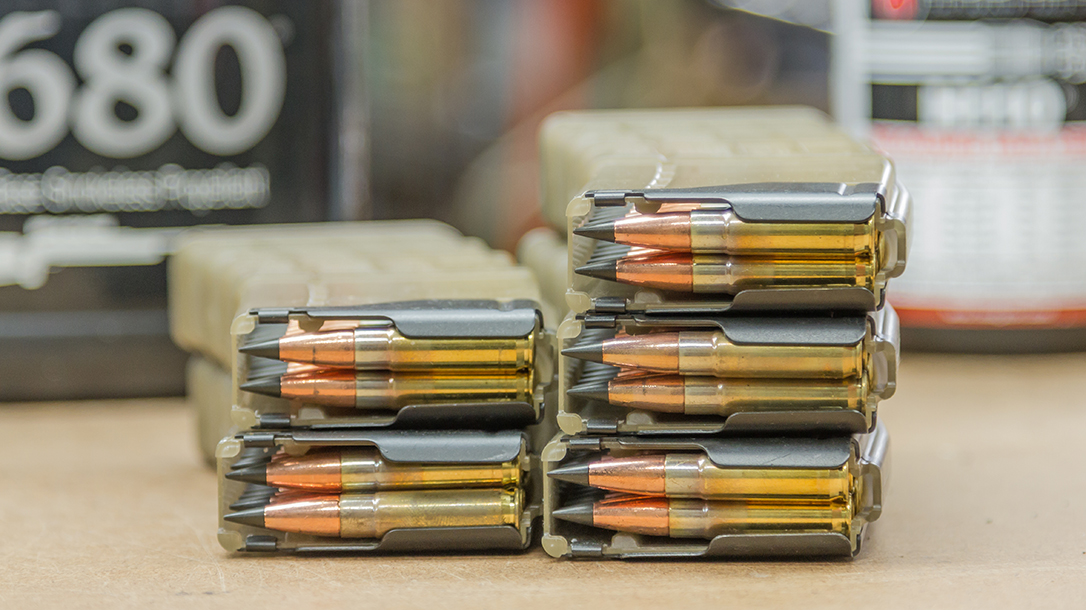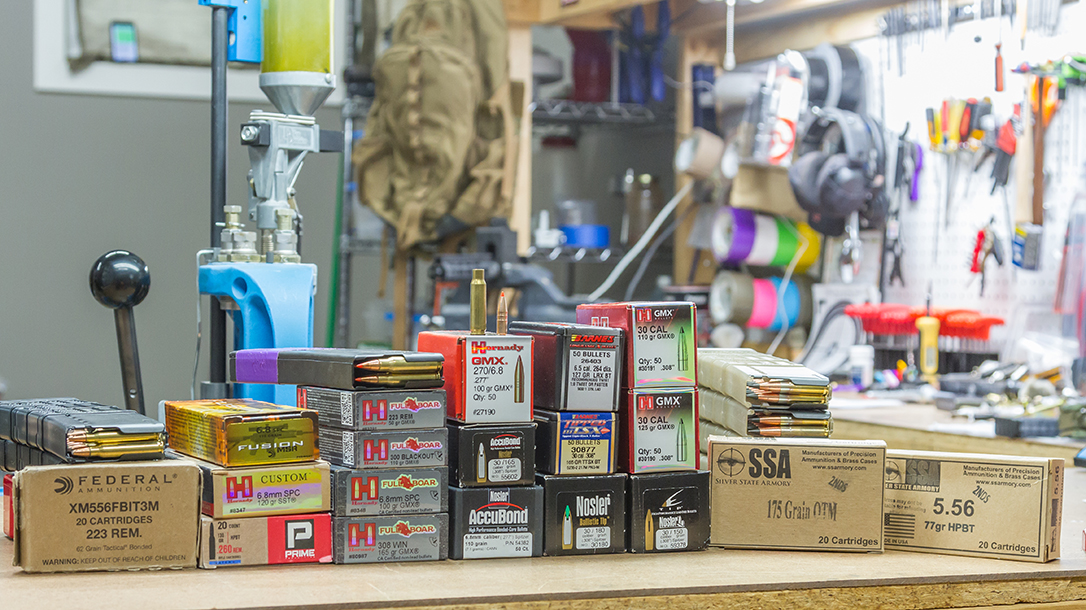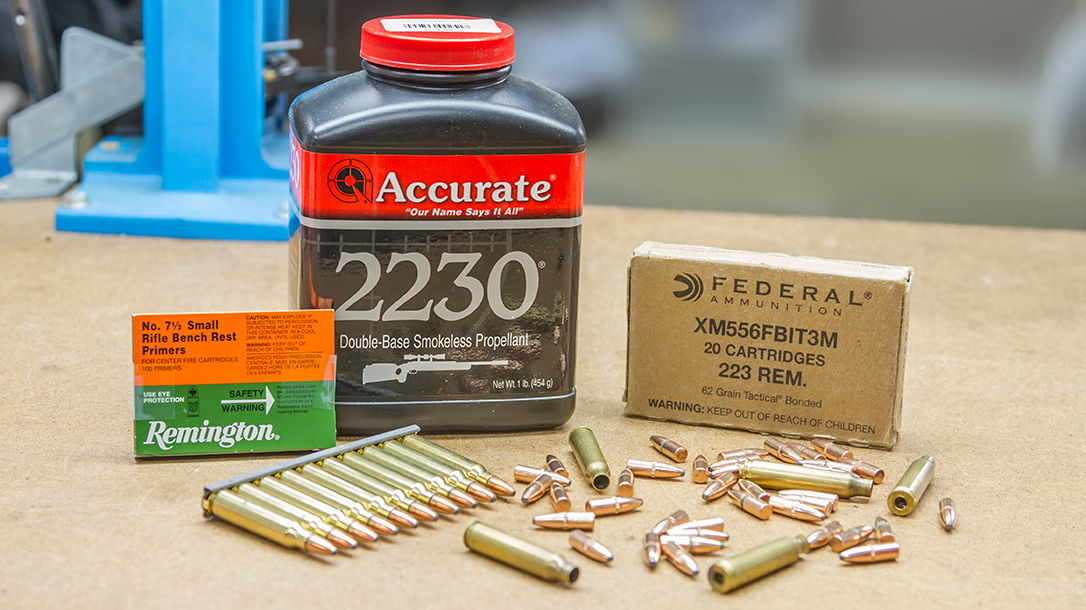The price of ammo, including tactical ammunition, is at its lowest point in a decade or more. Though I’m an avid handloader, and I enjoy the process of handloading enough to have written books and articles on handloading for years now, even I have succumbed to the allure of cheap factory ammo and let my reloading press sit idle for weeks at a time. But there’s a solid and lasting place for handloading in the tactical shooter’s inventory of skills and equipment. Throughout this year, we’ll go through the why and how of handloading duplicates of popular tactical ammunition available. This will be a multi-part series, so hang onto each issue for future reference.
Why would we want to duplicate “tactical” ammo with our handloads? Isn’t the point of handloading to tailor our ammo to a specific firearm or application? Aren’t we handloading to achieve the greatest degree of precision or highest velocity for our specific firearm? In some cases, the answer to these questions is yes. When we consider tactical ammo for personal defense or duty, however, things may be viewed from a different perspective. To establish that perspective, let’s first define what makes ammo “tactical” in the first place.
Advertisement — Continue Reading Below
Some Definitions
Tactical ammunition is designed and assembled to be used in the context of personal defense, law enforcement, or military defensive or offensive operations. Also, an examination of the specific needs of these endeavors reveals several requirements for tactical ammo that may not exist for match, hunting or plinking ammo. Of tremendous importance to the performance of tactical ammo is the design and construction of the bullet. Projectiles used in tactical ammo must quickly incapacitate the threat posed by an adversary. It’s common to encounter barriers like auto glass, sheet metal, wallboard and other construction materials. So projectiles must have the ability to penetrate, expand or fragment even after passing through these barriers.
Tactical ammunition powder must perform in situations at any hour of the day or night, under any conditions. Shots fired in low light can create a blinding, disorienting ball of fire at the muzzle without reduced-flash powder. Fights may occur on the hottest day of summer or the coldest night of winter. Temperature-stable propellants perform similarly across such a range of conditions to provide consistent pressure and velocity.
Tactical Ammunition Features
Tactical ammunition must be sealed against moisture to ensure reliable performance in any weather or after submersion. Additionally, this includes sealing the projectile at the case mouth and the primer in the pocket. It’s easy to see Marines coming ashore through the surf sustaining water-damaged ammunition if not properly sealed.
Advertisement — Continue Reading Below
Finally, the projectiles used in tactical ammo must be loaded to specific velocities to ensure performance as designed. Load a projectile designed for use in a 24-inch-barreled precision rifle into a compact rifle with a 12-inch barrel. That projectile may not perform as intended when striking tissue with significantly reduced velocity. This is one reason why we’ve begun to see more specific loads intended for use in short-barreled firearms.
Making The Case
Back to the original question, given the grave nature of the employment of tactical ammunition, why handload it at all? We’ve all heard about the potential liability of using handloads in a tactical situation. I’m not an advocate for allowing liability concerns to drive tactical decisions. But there are some practical reasons why it’s generally best to use factory ammo for tactical applications. Still, there are many reasons why we’d want to duplicate tactical loads with our handloads. Several of these reasons include loading ammo to be used in bullet testing or hunting, or to reduce the cost of training ammo that launches the same bullet at the same velocity as our tactical loads.
I have a carbine that absolutely loves the Black Hills Mk262 loading. With my handloads, I can fire training ammo that has nearly the identical 600-yard trajectory offered by the much more expensive Black Hills factory-loaded round. Another carbine favors the all-copper Barnes 70-grain TSX. Factory ammo costs around $1 or more per shot, but I can load an equivalent for around 30-percent less per round. Similarly, the 6.8mm 100-grain GMX monolithic from Hornady is crazy accurate and effective in tissue, but it’s somewhat expensive in factory form. I can also handload duplicates for around 40-percent less.
Advertisement — Continue Reading Below
Using Inexpensive Copies
Access to inexpensive duplicates of my preferred tactical loads allows me to get a zero (that I’ll confirm with a few rounds of the real thing) after changing an optic or rebarreling a carbine without shooting up all of my “real” tactical ammo. It allows me to conduct expansion testing of projectiles at various impact velocities by loading ammo to reduced velocities in order to match impact speeds at 100 to 200 yards or more without the need to actually shoot from those distances.
Or I can spend the day in the woods hunting, where I’m handling and moving with my carbine, maintaining familiarity with my firearm and taking down a 200-pound animal without burning my “good stuff” ammo. This can be a more serious limitation if your tactical ammunition is issued by your agency or department and must be accounted for when used.
More To Consider
When we’re loading tactical ammo for semi-auto firearms, there are some additional loading requirements that must be addressed. All powders do not work for any given cartridge. Even fewer will be optimal, especially in semi-auto firearms that require certain levels of pressure and timing for best functioning. More than simply matching muzzle velocity and accuracy, overall system performance must be considered when creating your handloads.
Advertisement — Continue Reading Below
Another process that is critical to the creation of service-quality tactical ammo is primer staking. I’ve seen AR-15-type rifles deadlined when a primer pops out of a case and lodges between the trigger and the bottom of the receiver. This isn’t a common occurrence, and the examples I’ve experienced or witnessed have happened over the course of hundreds of thousands of rounds of ammo fired through AR-15-type rifles in the last two decades. For the handloader, staking primer pockets is not something we can practically accomplish. This simply reinforces the idea that handloads are for non-duty use. Additionally, we should use validated and verified factory ammo for the most critical tactical applications.
Factory-loaded tactical ammo utilizes new brass. We handloaders are almost always resizing fired brass. Modern resizing dies usually do a great job of effectively resizing cases so that they can be chambered and fired again. Semi-auto firearms may benefit from (or require) the use of what are known as “small-base” resizing dies to ensure reliable functioning. Small-base dies take fired cases back down to dimensions closer to those of unfired brass. This can eliminate chambering and extraction issues in some semi-auto firearms, but reduced case life will result.
Advertisement — Continue Reading Below
Final Thoughts
Finally, the violent nature of the operating cycle of a semi-auto firearm requires that bullets be seated and held in the case neck firmly. This is usually accomplished with a case-mouth crimp. Further, most factory ammo uses bullets with a cannelure that’s rolled into the bullet to facilitate the addition of an optimal crimp. Cartridges loaded with inadequate crimp can suffer bullet setback. Also, during recoil the bullet slams into the feed ramp and pushes deeper into the case neck. Poor feeding, accuracy and pressure issues can also result. I use a crimping step when I load ammo for semi-autos that’s quick and effective. There are several good options on the market. But I’ve had great results with the inexpensive Lee Factory Crimp Die, and I own one for every tactical cartridge I load.
Throughout the remainder of 2019, we’re going to get specific with this concept of duplicating some of the most proven and respected factory tactical ammo. Additionally, we’ll pick several different types of .223 Remington and 5.56mm NATO, 300 Blackout, 6.8 SPC and .308 Winchester tactical loads and work up duplicates using off-the-shelf components that are available to handloaders. We’ll also compare velocities, precision, points of impact and functioning to ensure our handloads offer true substitutes for our chosen tactical loads. Through this process, we’ll come up with great handloaded ammo using top-shelf projectiles that we can employ for all the reasons given in this article or any others that fit your needs. So, prepare to exceed your own expectations.
This article is from the March 2019 issue of Tactical Life magazine. Grab your copy at OutdoorGroupStore.com. For digital editions, visit Amazon.
Advertisement — Continue Reading Below


























